Characterizing Drought Effects on Vegetation Productivity in the Four Corners Region of the US Southwest
Abstract
:1. Introduction
2. Study Area and Data
2.1. Study Area
2.2. Datasets
2.2.1. Remote Sensing Data
3. Methodology
3.1. Response Variable: Deriving Annual Metric of Vegetation Productivity
3.2. Explanatory Variables
3.3. Detecting Multicollinearity among the Explanatory Variables
3.4. Interannual Variability of NDVI-Related Productivity Parameter
3.5. Vegetation Productivity–Environment Relationships
4. Results and Discussion
4.1. Spatial Patterns of Interannual CoV of the Productivity Variable
4.2. Vegetation Productivity as a Function of Environmental Drivers
4.3. Vegetation Type Productivity Response to the Potential Environmental Variables
5. Discussion
6. Conclusions
Author Contributions
Acknowledgments
Conflicts of Interest
References
- Wilhite, D.A. The enigma of drought: Management and policy issues for the 1990s. Int. J. Environ. Stud. 1990, 36, 41–54. [Google Scholar] [CrossRef]
- Glantz, M. Climate Affairs: A Primer; Island Press: Washington, DC, USA, 2003; 291p, ISBN 1559639199. [Google Scholar] [CrossRef]
- Wu, C.; Chen, J.M. Diverse responses of vegetation production to interannual summer drought in North America. Int. J. Appl. Earth Obs. Geoinf. 2013, 21, 1–6. [Google Scholar] [CrossRef]
- Herrmann, S.M.; Didan, K.; Barreto-Munoz, A.; Crimmins, M.A. Divergent responses of vegetation cover in Southwestern US ecosystems to dry and wet years at different elevations. Environ. Res. Lett. 2016, 11, 124005. [Google Scholar] [CrossRef]
- Easterling, D.R.; Evans, J.L.; Groisman, P.Y.; Karl, T.R.; Kunkel, K.E.; Ambenje, P. Observed variability and trends in extreme climate events: A brief review. Bull. Am. Meteorol. Soc. 2000, 81. [Google Scholar] [CrossRef]
- The Intergovernmental Panel on Climate Change (IPCC). Climate Change 2007: Impacts, Adaptation and Vulnerability; Contribution of Working Group II to the Fourth Assessment Report of the Intergovernmental Panel on Climate Change; Parry, M.L., Canziani, O.F., Palutikof, J.P., van der Linden, P.J., Hanson, C.E., Eds.; Cambridge University Press: Cambridge, UK, 2007; 976p, Available online: https://www.ipcc.ch/pdf/assessment-report/ar4/wg2/ar4-wg2-intro.pdf (accessed on 15 May 2016).
- Food and Agriculture Organization (FAO). Drought-Related Food Insecurity: A Focus on the Horn of Africa. In Proceedings of the Emergency Ministerial-Level Meeting, Rome, Italy, 25 July 2011; Available online: http://www.fao.org/crisis/28402–0f9dad42f33c6ad6ebda108ddc1009adf.pdf (accessed on 22 October 2017).
- Chen, G.; Tian, H.; Zhang, C.; Liu, M.; Ren, W.; Zhu, W.; Lockaby, G.B. Drought in the southern united states over the 20th century: Variability and its impacts on terrestrial ecosystem productivity and carbon storage. Clim. Chang. 2012, 114, 379–397. [Google Scholar] [CrossRef]
- Parida, B.R.; Oinam, B. Drought monitoring in India and the Philippines with satellite remote sensing measurement. EARSeL eProc. 2008, 7, 81–91. Available online: http://www.eproceedings.org (accessed on 6 February 2016).
- Mishra, A.K.; Singh, V.P. A review of drought concepts. J. Hydrol. 2010, 391, 202–216. [Google Scholar] [CrossRef]
- Ross, T.; Lott, N. A Climatology of 1980–2003 Extreme Weather and Climate Events; US Department of Commerece, National Ocanic and Atmospheric Administration, National Environmental Satellite Data and Information Service, National Climatic Data Center: Asheville, NC, USA, 2003. Available online: https://library.villanova.edu/Find/Record/1121254 (accessed on 26 May 2017).
- Cook, E.R.; Seager, R.; Cane, M.A.; Stahle, D.W. North american drought: Reconstructions, causes, and consequences. Earth Sci. Rev. 2007, 81, 93–134. [Google Scholar] [CrossRef]
- Seager, R.; Ting, M.; Held, I.; Kushnir, Y.; Lu, J.; Vecchi, G.; Naik, N. Model projections of an imminent transition to a more arid climate in southwestern north america. Science 2007, 316, 1181–1184. [Google Scholar] [CrossRef] [PubMed]
- Breshears, D.D.; Cobb, N.S.; Rich, P.M.; Price, K.P.; Allen, C.D.; Balice, R.G.; Belnap, J. Regional vegetation die-off in response to global-change-type drought. Proc. Natl. Acad. Sci. USA 2005, 102, 15144–15148. [Google Scholar] [CrossRef] [PubMed]
- Weiss, J.L.; Castro, C.L.; Overpeck, J.T. Distinguishing pronounced droughts in the Southwestern United States: Seasonality and effects of warmer temperatures. J. Clim. 2009, 22, 5918–5932. [Google Scholar] [CrossRef]
- El-Vilaly, M.A.S.; Didan, K.; Marsh, S.E.; van Leeuwen, W.J.; Crimmins, M.A.; Munoz, A.B. Vegetation productivity responses to drought on tribal lands in the four corners region of the Southwest USA. Front. Earth Sci. 2017, 12, 37–51. [Google Scholar] [CrossRef]
- Tadesse, T.; Wilhite, D.A.; Hayes, M.J.; Harms, S.K.; Goddard, S. Discovering associations between climatic and oceanic parameters to monitor drought in nebraska using data-mining techniques. J. Clim. 2005, 18, 1541–1550. [Google Scholar] [CrossRef]
- Chapin, F.S., III; Matson, P.A.; Vitousek, P. Principles of Terrestrial Ecosystem Ecology; Springer: New York, NY, USA, 2011. [Google Scholar] [CrossRef]
- Crimmins, M.A.; Selover, N.; Cozzetto, K.; Chief, K.; Meadow, A. Technical Review of the Navajo Nation Drought Contingency Plan—Drought Monitoring. Ecol. Appl. Ecol. Appl. 2013, 22, 104–118. Available online: http://cals.arizona.edu/climate/pubs/Navajo_Nation_Drought_Plan_Technical_Review.pdf (accessed on 13 April 2016).
- Swetnam, T.W.; Betancourt, J.L. Mesoscale disturbance and ecological response to decadal climatic variability in the american southwest. In Tree Rings and Natural Hazards; Springer: Dordrecht, The Netherlands, 2010; pp. 329–359. [Google Scholar] [CrossRef]
- Gastélum, J.R.; Cullom, C. Application of the colorado river simulation system model to evaluate water shortage conditions in the central arizona project. Water Resour. Manag. 2013, 27, 2369–2389. [Google Scholar] [CrossRef]
- Grahame, J.D.; Sisk, T.D. Canyons, Cultures and Environmental Change: An Introduction to the Land Use History of the Colorado Plateau; Flagstaff, Northern Arizona University database: Flagstaff, AZ, USA, 2002; Available online: http://www.cpluhna.nau.edu/ (accessed on 15 January 2016).
- Didan, K. Multi-Satellite Earth Science Data Record for Studying Global Vegetation Trends and Changes. IGARSS2010. 2010. Available online: https://pdfs.semanticscholar.org/9d77/006e8d0ff61ef13d9833a142da0f47ec63d1.pdf (accessed on 10 June 2016).
- Didan, K.; Barreto, A.M.; Miura, T.; Tsend-Ayush, J.; Zhang, X.; Friedl, M.; Gray, J.; Van Leeuwen, W.; Czapla-Myers, J.; Doman Bennett, S.; et al. Multi-Sensor Vegetation Index and Phenology Earth Science Data Records: Algorithm Theoretical Basis Document and User Guide Version 4.0. Available online: https://vip.arizona.edu/VIP_ATBD_UsersGuide.php (accessed on 22 March 2016).
- Di Luzio, M.; Johnson, G.L.; Daly, C.; Eischeid, J.; Arnold, J.G. Constructing Retrospective Gridded Daily Precipitation and Temperature Datasets for the Conterminous United States. J. Appl. Meteorol. Climatol. 2008, 47, 475–497. [Google Scholar] [CrossRef]
- North American Land Change Monitoring System (NALCMS). North American Land Cover at 250 m Spatial Resolution. Produced by Natural Resources Canada/Canadian Center for Remote Sensing (NRCan/CCRS), United States Geological Survey (USGS); Insituto Nacional de Estadística y Geografía (INEGI), Comisión Nacional para el Conocimiento y Uso de la Biodiversidad (CONABIO) and Comisión Nacional Forestal (CONAFOR). 2005. Available online: https://landcover.usgs.gov/nalcms.php (accessed on 16 January 2016).
- Tucker, C.J.; Justice, C.O.; Prince, S.D. Monitoring the grasslands of the Sahel 1984–1985. International J. Remote Sens. 1986, 7, 1571–1581. [Google Scholar] [CrossRef]
- Running, S.W.; Thornton, P.E.; Nemani, R.; Glassy, J.M. Global terrestrial gross and net primary productivity from the Earth Observing System. Methods Ecosyst. Sci. 2000, 3, 44–45. [Google Scholar] [CrossRef]
- Delbart, N.; Le Toan, T.; Kergoat, L.; Fedotova, V. Remote sensing of spring phenology in boreal regions: A free of snow-effect method using NOAA-AVHRR and SPOT-VGT data (1982–2004). Remote Sens. Environ. 2006, 101, 52–62. [Google Scholar] [CrossRef]
- White, M.A.; Thornton, P.E.; Running, S.W.; Nemani, R.R. Parameterization and sensitivity analysis of the BIOME–BGC terrestrial ecosystem model: Net primary production controls. Earth Interact. 2000, 4. [Google Scholar] [CrossRef]
- Walker, E. Detection of collinearity-influential observations. Commun. Stat. Theory Methods 1989, 18, 1675–1690. [Google Scholar] [CrossRef]
- Castillo-Santiago, M.Á.; Ghilardi, A.; Oyama, K.; Hernández-Stefanoni, J.L.; Torres, I.; Flamenco-Sandoval, A.; Mas, J. Estimating the spatial distribution of woody biomass suitable for charcoal making from remote sensing and geostatistics in central mexico. Energy Sustain. Dev. 2012. [Google Scholar] [CrossRef]
- Davison, J.E.; Breshears, D.D.; Van Leeuwen, W.J.D.; Casady, G.M. Remotely sensed vegetation phenology and productivity along a climatic gradient: On the value of incorporating the dimension of woody plant cover. Glob. Ecol. Biogeogr. 2011, 20, 101–113. [Google Scholar] [CrossRef]
- Kariyeva, J.; van Leeuwen, W.J.D. Environmental drivers of NDVI-based vegetation phenology in central Asia. Remote Sens. 2011, 3, 203–246. [Google Scholar] [CrossRef]
- Weiss, E.; Marsh, S.E.; Pfirman, E.S. Application of NOAA-AVHRR NDVI time-series data to assess changes in Saudi Arabia’s rangelands. Int. J. Remote Sens. 2001, 22, 1005–1027. [Google Scholar] [CrossRef]
- Jordan, Y.C.; Ghulam, A.; Herrmann, R.B. Floodplain ecosystem response to climate variability and land-cover and land-use change in lower Missouri river basin. Landsc. Ecol. 2012, 27, 843–857. [Google Scholar] [CrossRef]
- Härdle, W.K.; Simar, L. Applied Multivariate Statistical Analysis; Springer: Berlin/Heidelberg, Germany, 2012. [Google Scholar] [CrossRef]
- Harper, A.B.; Denning, A.S.; Baker, I.T.; Branson, M.D.; Prihodko, L.; Randall, D.A. Role of deep soil moisture in modulating climate in the Amazon rainforest. Geophys. Res. Lett. 2010, 37. [Google Scholar] [CrossRef]
- Allen, C.D.; Macalady, A.K.; Chenchouni, H.; Bachelet, D.; McDowell, N.; Vennetier, M.; Gonzalez, P. A global overview of drought and heat-induced tree mortality reveals emerging climate change risks for forests. For. Ecol. Manag. 2010, 259, 660–684. [Google Scholar] [CrossRef]
- Easterling, D.R.; Arnold, J.; Knutson, T.; Kunkel, K.; LeGrande, A.; Leung, L.R.; Wehner, M. Precipitation change in the United States. In Climate Science Special Report: Fourth National Climate Assessment, Volume I; Wuebbles, D.J., Fahey, D.W., Hibbard, K.A., Dokken, D.J., Stewart, B.C., Maycock, T.K., Eds.; U.S. Global Change Research Program: Washington, DC, USA, 2017; pp. 207–230. [Google Scholar] [CrossRef]

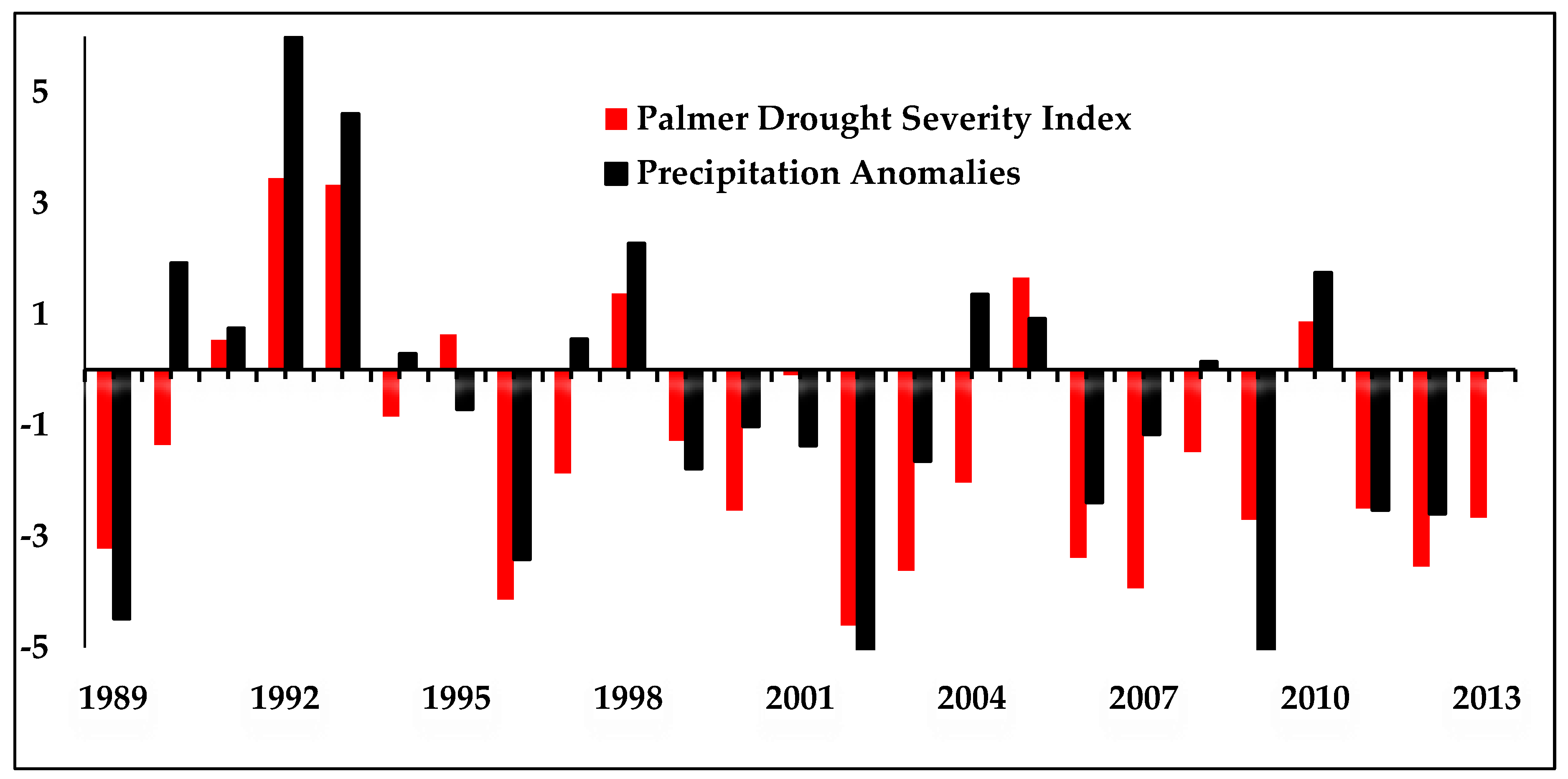
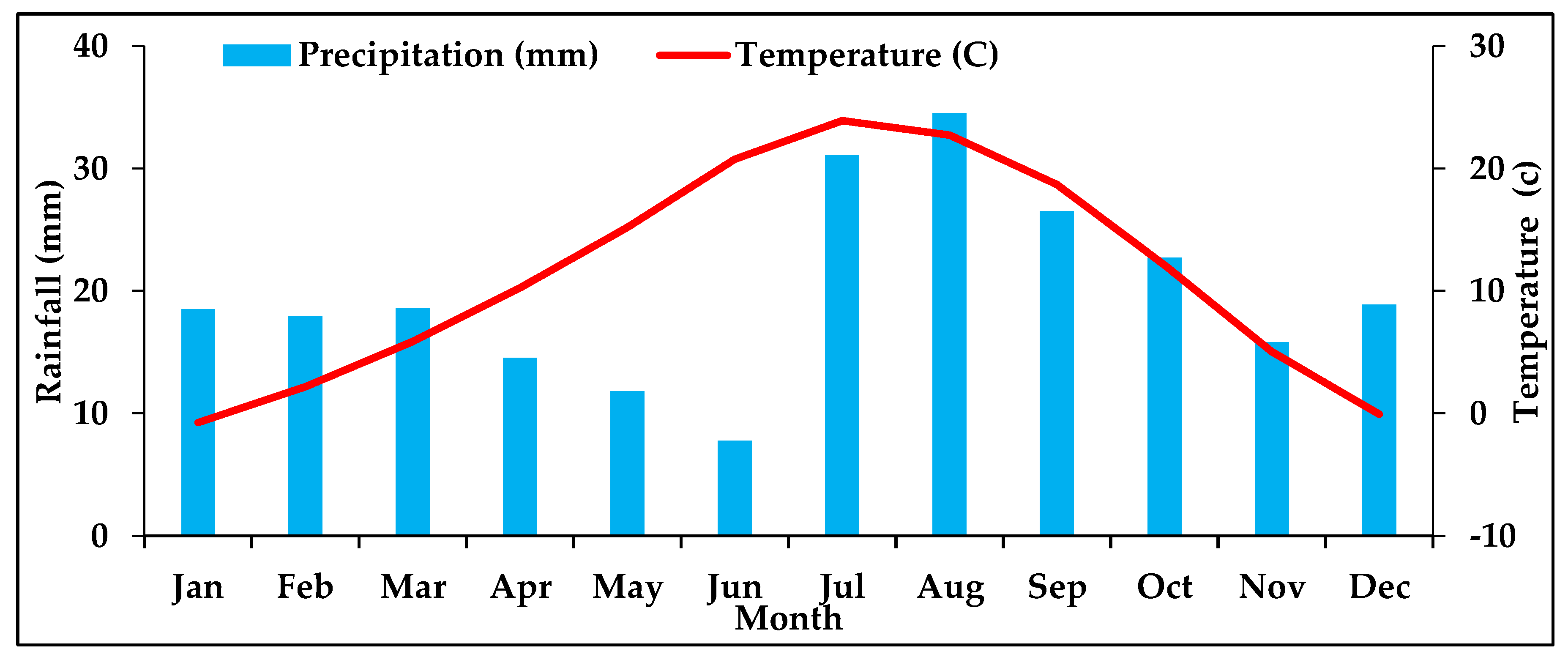
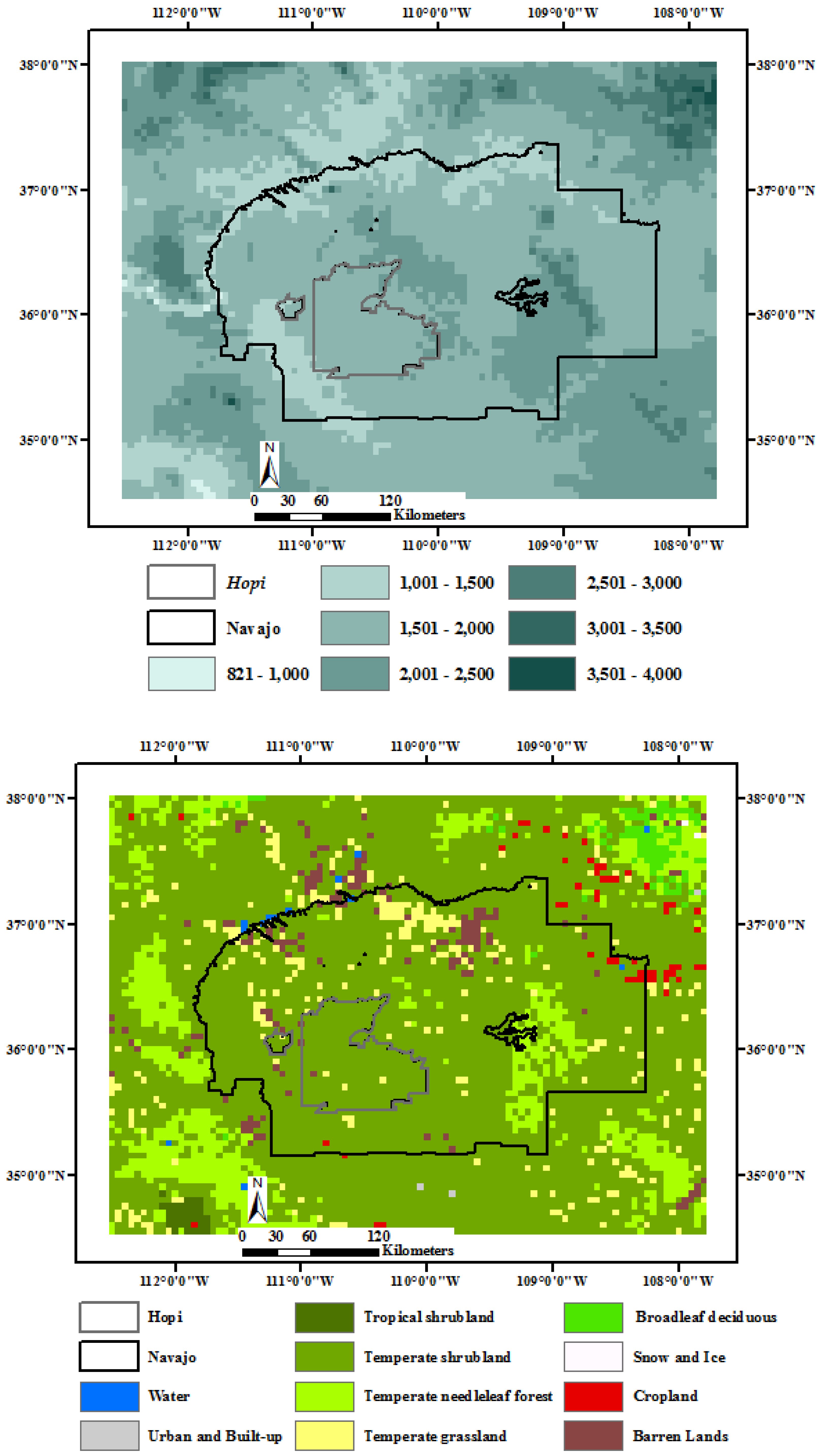

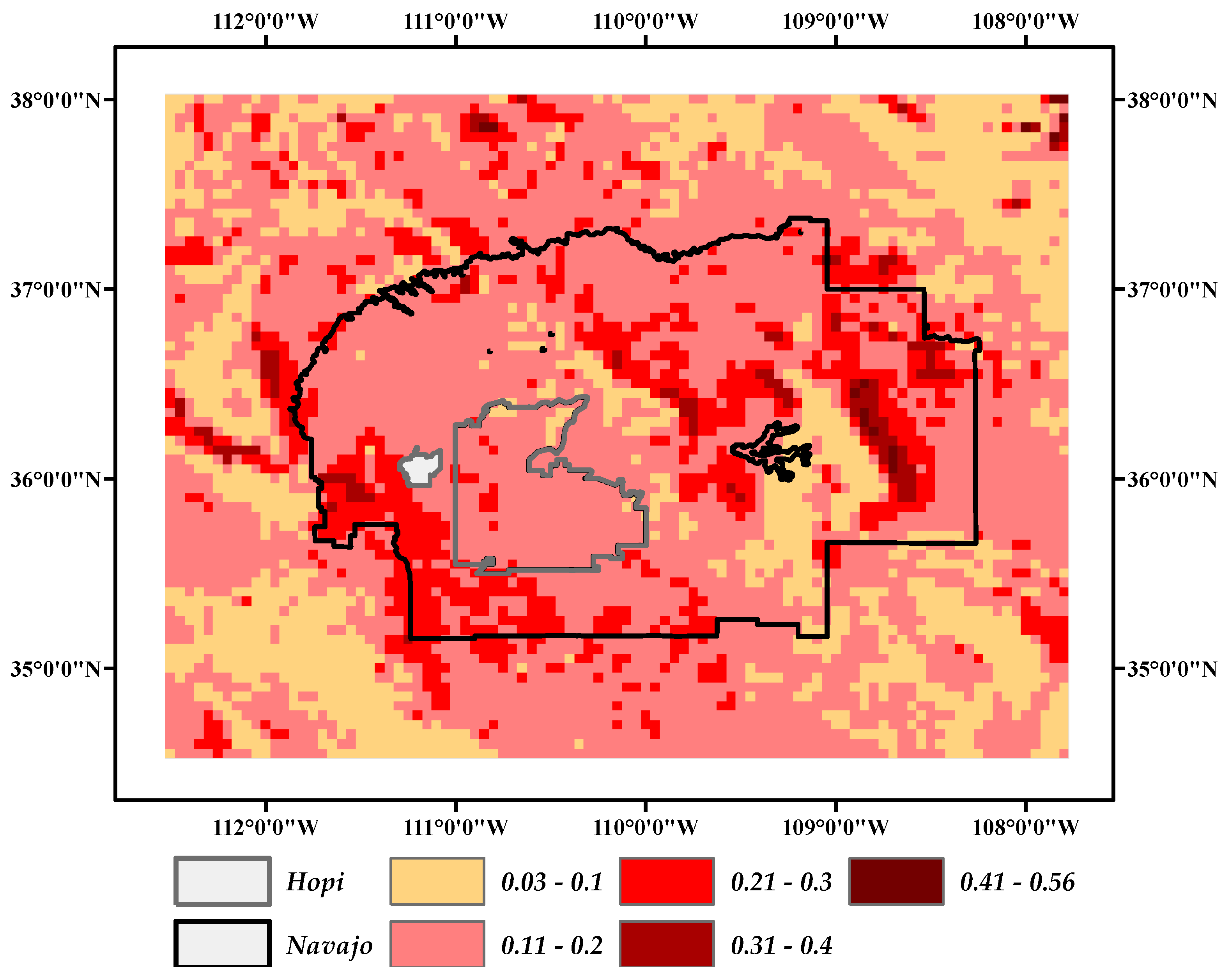
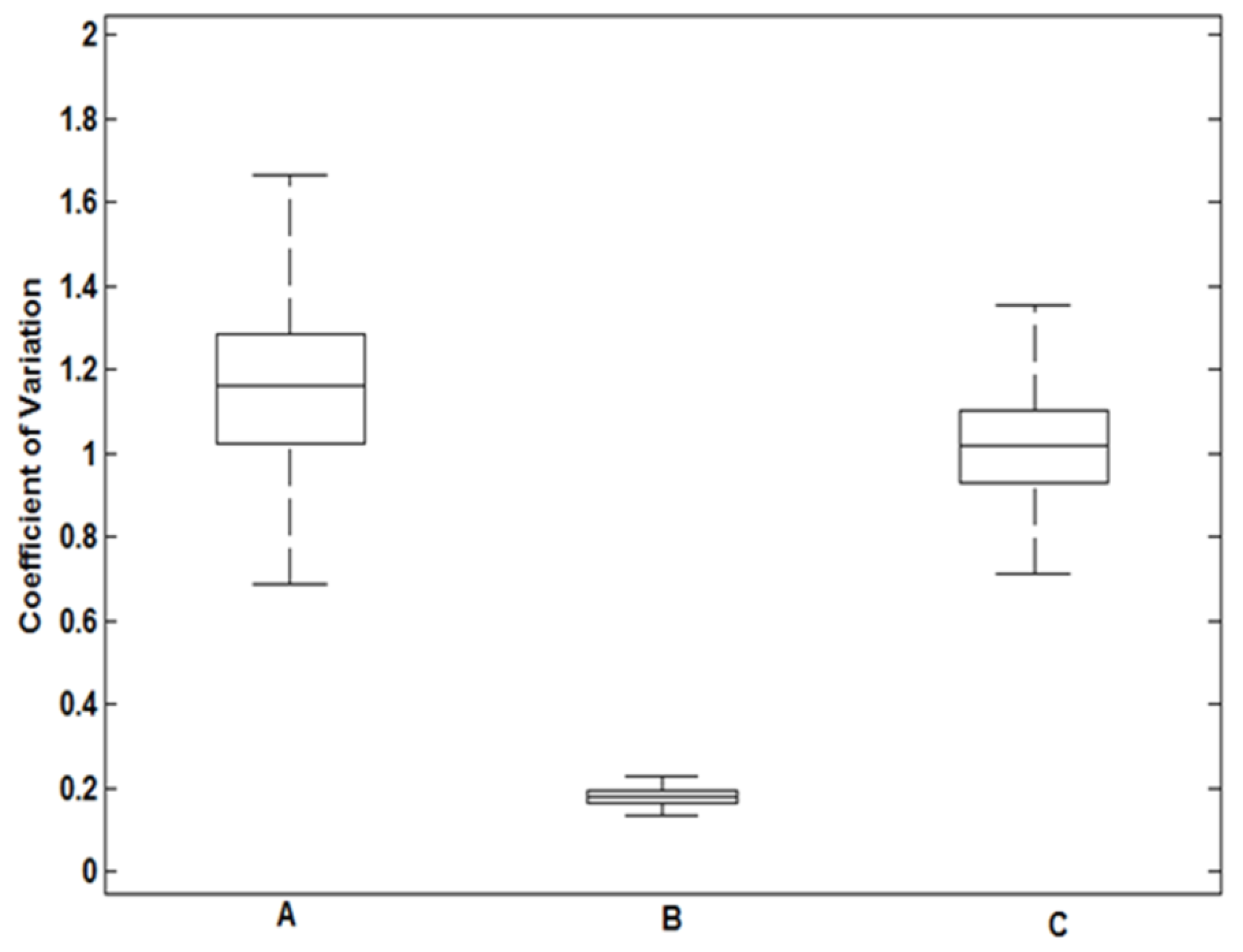

| Variables | Derived Variables |
|---|---|
| Topographical characteristics |
|
| Climate data |
|
| Vegetation types |
|
| Explanatory Variables | Estimated Coefficient | Standard Errors | p-Value |
|---|---|---|---|
| Fall precipitation | −0.22 | 0.018 | 5.82 × 10−35 |
| Fall temperature | 1.08 | 0.17 | 7.93 × 10−12 |
| Spring precipitation | 0.13 | 0.02 | 1.003 × 10−11 |
| Summer precipitation | −0.164 | 0.015 | 2.23 × 10−26 |
| Summer temperature | −0.68 | 0.18 | 0.005 |
| Winter precipitation | 0.05 | 0.014 | 1.69 × 10−4 |
| Winter temperature | −0.69 | 0.087 | 4.72 × 10−13 |
| Aspect | −0.0001 | 9.07 × 10−6 | 1.36 × 10−36 |
| Elevation | −8.58 × 10−5 | 5.47 × 10−6 | 3.1 × 10−52 |
| Vegetation types | 0.001 | 4.82 × 10−4 | 4.56 × 10−5 |
| Whole model | Intercept = 0.48 RMSE = 0.002 Adjusted R-Square = 0.37 p-value = 1.51 × 10−171 | ||
| Explanatory Variables | Estimated Coefficient | Standard Errors | p-Value |
|---|---|---|---|
| Fall precipitation | −0.17 | 0.03 | 1.5 × 10−6 |
| Spring temperature | −1.06 | 0.39 | 0.007 |
| Aspect | 6.57 × 10−5 | 2.71 × 10−5 | 0.016 |
| Whole model | Intercept = 0.32 RMSE = 0.03 Adjusted R-Square = 0.23 p-value = 8.31 × 10−8 | ||
| Variables | Estimated Coefficient | Standard Errors | p-Value |
|---|---|---|---|
| Fall precipitation | −0.22 | 0.02 | 6.25 × 10−27 |
| Fall temperature | 1.07 | 0.19 | 2.16 × 10−8 |
| Spring precipitation | 0.16 | 0.02 | 8.22 × 10−14 |
| Summer precipitation | −0.18 | 0.02 | 1.47 × 10−23 |
| Winter precipitation | 0.05 | 0.02 | 0.0016 |
| Winter temperature | −0.72 | 0.09 | 4.48 × 10−14 |
| Aspect | −1.21 × 10−4 | 1.02 × 10−5 | 2.07 × 10−31 |
| Elevation | −8.68 × 10−5 | 6.05 × 10−6 | 1.30 × 10−44 |
| Whole model | Intercept = 0.37 RMSE = 0.04 Adjusted R-Square = 0.31 p-value = 1.06 × 10−158 | ||
| Variables | Estimated Coefficient | Standard Errors | p-Value |
|---|---|---|---|
| Fall precipitation | −0.13 | 0.04 | 0.002 |
| Aspect | −1.32 | 0.39 | 0.007 |
| Elevation | 6.57 × 10−5 | 3 × 10−5 | 1.9 × 10−5 |
| Whole model | Intercept = 0.31 RMSE = 0.036 Adjusted R-Square = 0.28 p-value = 3.091 × 10−10 | ||
© 2018 by the authors. Licensee MDPI, Basel, Switzerland. This article is an open access article distributed under the terms and conditions of the Creative Commons Attribution (CC BY) license (http://creativecommons.org/licenses/by/4.0/).
Share and Cite
EL-Vilaly, M.A.S.; Didan, K.; Marsh, S.E.; Crimmins, M.A.; Munoz, A.B. Characterizing Drought Effects on Vegetation Productivity in the Four Corners Region of the US Southwest. Sustainability 2018, 10, 1643. https://doi.org/10.3390/su10051643
EL-Vilaly MAS, Didan K, Marsh SE, Crimmins MA, Munoz AB. Characterizing Drought Effects on Vegetation Productivity in the Four Corners Region of the US Southwest. Sustainability. 2018; 10(5):1643. https://doi.org/10.3390/su10051643
Chicago/Turabian StyleEL-Vilaly, Mohamed Abd Salam, Kamel Didan, Stuart E. Marsh, Michael A. Crimmins, and Armando Barreto Munoz. 2018. "Characterizing Drought Effects on Vegetation Productivity in the Four Corners Region of the US Southwest" Sustainability 10, no. 5: 1643. https://doi.org/10.3390/su10051643
APA StyleEL-Vilaly, M. A. S., Didan, K., Marsh, S. E., Crimmins, M. A., & Munoz, A. B. (2018). Characterizing Drought Effects on Vegetation Productivity in the Four Corners Region of the US Southwest. Sustainability, 10(5), 1643. https://doi.org/10.3390/su10051643





